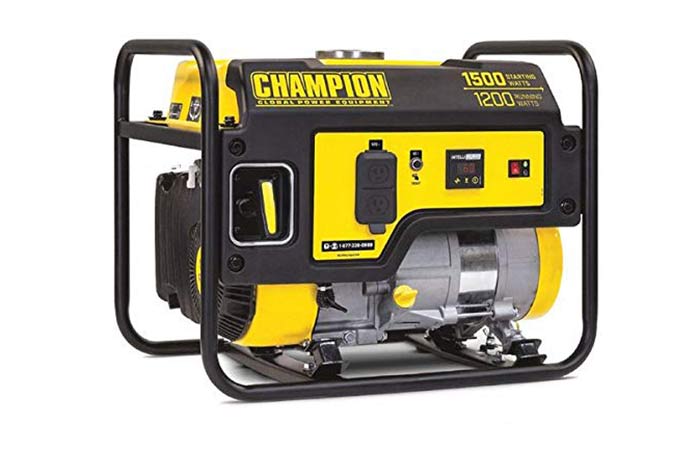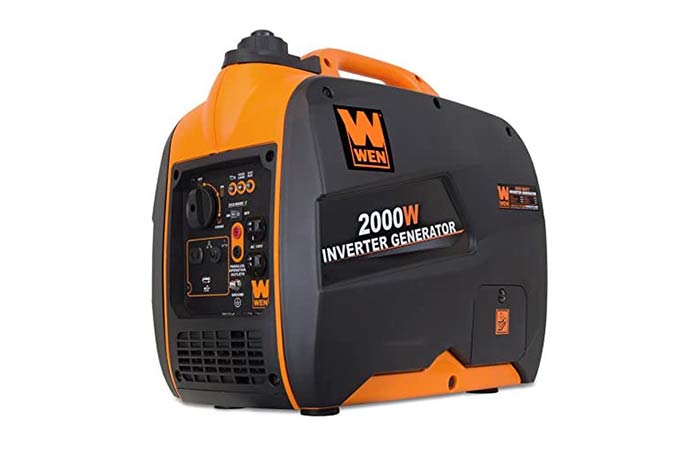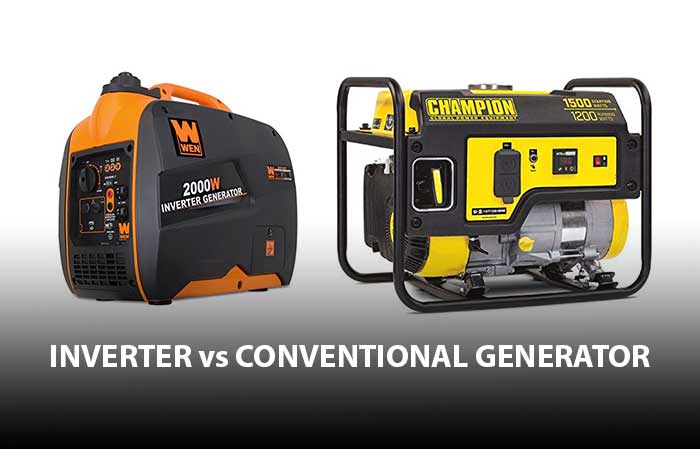Conventional generators, simply referred to as generators, are the most common type of generators in the home and workplace. On the other hand, there are the newer inverter generators which, although fewer than the conventional ones, are quickly gaining popularity thanks to the features they come with.
Conventional generators use either diesel, gas, propane or natural gas to run. They provide DC (direct current) and are usually large and a bit noisy. They are most used as standby generators given their large sizes and long runtimes. A lot of generators used in homes and places of work are of the conventional type.
Inverter generators, on the other hand, have almost the same features as their conventional alternatives save for the addition of an inverter which converts the DC current to AC (alternating current). The result of this seemingly minor change is a major one in terms of size, noise level, weight and other aspects.
We compare the two in this article and help you make the decision between them. We focus on aspects such as the cost, fuel used, size, noise levels and others. In our view, the inverter generator edges the conventional one in several major areas.
Comparison
1. Power stability
The main difference between the two types of generators is the stability of the power generated. This emanates from the inclusion of an inverter in the inverter generators and the lack of one in the conventional generators.

The conventional generator produces power in AC current which is then converted to DC current by the alternator. They’re also meant to run at a constant RPM of 3600 while generating 120 Volts of power at 60 Hertz. This isn’t usually achievable as the engine usually fluctuates in the RPM produced and thus the voltage and Hertz will change with the RPM. The power generated has harmonic distortion which makes it unsafe for the power-sensitive equipment such as mobile phone and TVs.
The inverter generator, on the other hand, has all these features but it has an inverter which, after the alternator converts AC power to DC, converts it back to AC current. It stabilizes this power and eliminates any harmonic distortions to make it clean and usable with power-sensitive equipment such as TVs and mobile phones.
Winner: In this regard, the inverter generator wins.
2. Fuel used
For the fuel used, both types of generators use the same types of fuel which are either diesel, gasoline, propane or natural gas. While the consumption levels are different, using the same types of fuel is an advantage when choosing between the two of them.
Winner: For this one, it’s a draw.
3. Level of noise produced
The level of noise created by a generator is measured in decibels. The higher the number of decibels, the noisier it is. While noise isn’t usually an issue when a generator is located far from the house or van or other place where the power is being used, it’s always an issue when close by. As such, getting the quietest generator is a priority. The one thing you need to know about decibels is that increasing it by 10 units doubles the sound level. As such, a 20-decibel sound will be twice louder than a 10-decibel one.

For the two types of generators, the inverter types are way quieter than the others in general. On average, an inverter generator will produce about 54 to 58 decibels of noise compared to about 64 decibels for the conventional types. 64 decibels aren’t too much noise although it can get disturbing when close to the generator and for a significant amount of time.
Winner: The inverter generators are relatively quieter.
4. Efficiency
The efficiency in question for these generators is the fuel consumption in relation to the power produced. Conventional generators are created to run at a constant 3600 rpm no matter the power being drawn from them. While they may fluctuate every now and again, the general level is 3600 rpm. This means that the fuel consumed is also relatively constant over a given period of time and load.
The inverter generators have an edge here as they are made to throttle up or down as per the power needed. As such, it’ll have a higher RPM if the load is higher and a lower RPM if the power needed is less. As a result of this, inverter generators are more efficient.
Winner: The inverter generators are more efficient.
5. Level of maintenance needed
For conventional generators, there is the constant need to check for the oil and coolant levels, checking the air filter and generally carrying out periodic maintenance practices. They need an oil change on average every 200 hours of runtime. Part of the reason for this is their relatively larger size compared to the inverter type.
The inverter generators, being smaller and more efficient, require much less maintenance over their lifetime. While you’ll need to carry out maintenance practices such as checking the air filter, replacing the oil and others, the main concern is on the batteries which should be checked for power. If they’re flat, they should be charged.
Winner: The winner is the inverter generator for needing less maintenance.
6. Cost of purchase
Already, we’ve seen a few differences in which the inverter generator mostly edges the conventional one. This means that, if you want a generator with a specific number of Watts for the output, you will be getting more for the inverter generator. This translates into more costs for the inverter generator. Essentially, you pay more for inverter generators given the advantages they come with.
Winner: The conventional generator is cheaper and hence the winner.
7. Physical size
For the same amount of Watts, a conventional generator will usually be bigger than an inverter generator. This doesn’t mean that they’ll be having less features as they’ll be having similar or even better features. There are some inverter generators the size of a carrycase that produce thousands of Watts.
Winner: The inverter generators are better as they’re smaller for the same amount of output.
8. Level of safety
The safety facets to look at are how easy it is to secure the generator and the safety to the users. Being smaller, inverter generators are much safer to secure as they can be easily carried around. When constructing a shed for them, you’ll spend less as you’ll need less of a shade than for a conventional generator of a similar Wattage.
Their smaller size also makes inverter generators easier to steal when they fall into the wrong hands. With most inverter generators being the size of a medium-sized suitcase, a thief can easily put a few of them into the trunk of a car and they’ll be gone in no time. Conventional generators are usually too large to simply carry away if they fall into the wrong hands.
The other aspect is the safety to the user. Generators produce carbon monoxide gas which is very dangerous to the users. While not exclusive to inverter generators, more and more of these generators are being bundled with a carbon monoxide sensor. This sensor automatically shuts off the generator whenever the levels of carbon monoxide reach a certain level. This prevents deaths to the users which is a major advantage.
Winner: This is a draw since the safety features of the generators balance out.
9. Modular compatibility
Modular compatibility refers to the ability of the generators to be connected and supply power as a single unit. In this regard, you can have smaller generators connected in parallel to generate power equal to a single large generator.
Modular compatibility is available for both types of generators although you will find more inverter generators having this feature. Being smaller and with more stable power makes them much easier to work in parallel with each other. Also, the fact that they’ll throttle up and down as per the power demands means that some generators will even go off in a modular connection when the power needs are low.
Winner: The inverter generator is more suited to modular compatibility hence the winner.
10. Level of emissions
Due to their efficiency, inverter generators will emit less harmful gasses and other compounds into the air compared to conventional generators for the same amount of time. The fact that inverter generators convert DC power into AC power means that they’ll have much more power for the same amount of fuel as the conventional generators. It doesn’t mean they don’t have emissions since all combustion engines produce emissions.
Winner: The inverter generator has less emissions and thus the winner.
11. Power generated
When buying a generator, your main concern should be the amount of power produced. And, while you’ll always find the size of generator you need for both inverter and conventional generators, most large generators are the conventional type. These include most standby generators with tens of thousands of Watts. While you’ll still find inverter generators with this power output, they are fewer than the conventional ones.
Winner: Draw. A slight edge for the conventional generators but generally a draw.
Comparison Table
| Feature | Conventional Generator | Inverter Generator |
| Power stability | Mildly unstable | Stable |
| Fuel types | Diesel, gas, propane, natural gas | Diesel, gas, propane, natural gas |
| Noise levels | More: 64 decibels on average | Less: 54 decibels on average |
| Efficiency | Less efficient | More efficient |
| Maintenance level | Medium | Low |
| Cost of purchase | Medium | High |
| Physical size | Large | Small |
| Safety levels | Medium | High |
| Modular compatibility | Medium | High |
| Level of emissions | Medium | Low |
| Power generated | High | High |
Which is Better?
From the comparison above, the inverter generators edge the conventional ones due to having various advantages among them more stable power, lower noise levels, more efficiency, low maintenance levels, being smaller, safer, having less emissions and being better at modular compatibility.
Further Reading
